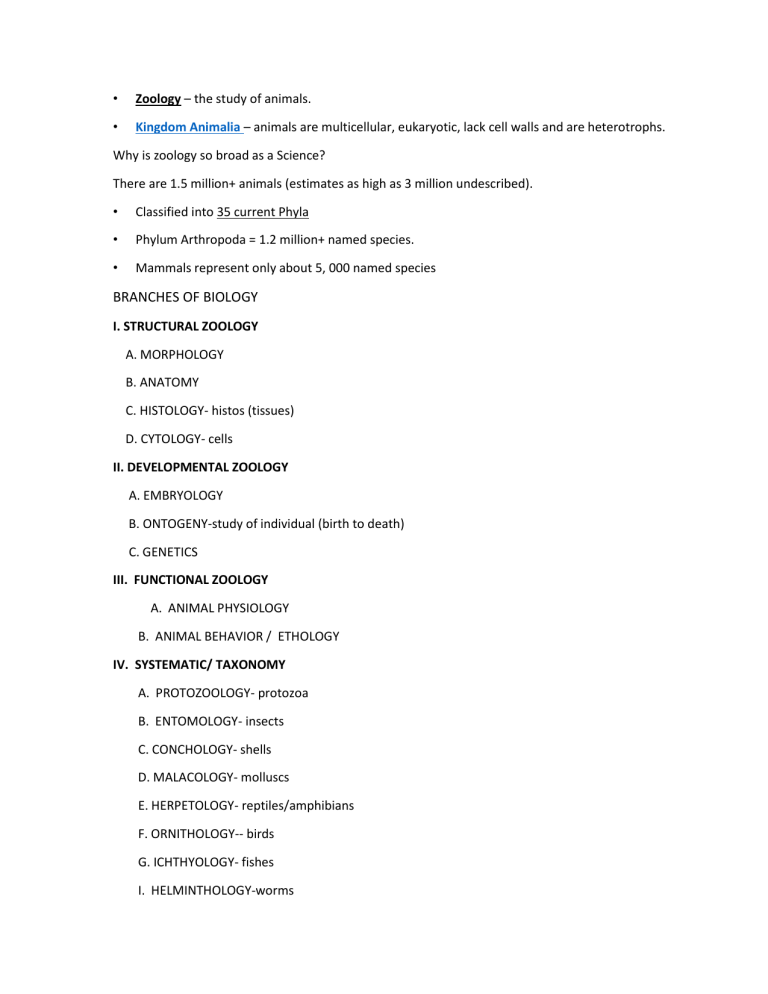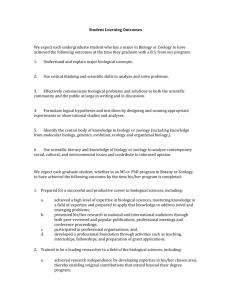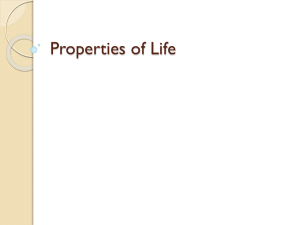
• Zoology – the study of animals. • Kingdom Animalia – animals are multicellular, eukaryotic, lack cell walls and are heterotrophs. Why is zoology so broad as a Science? There are 1.5 million+ animals (estimates as high as 3 million undescribed). • Classified into 35 current Phyla • Phylum Arthropoda = 1.2 million+ named species. • Mammals represent only about 5, 000 named species BRANCHES OF BIOLOGY I. STRUCTURAL ZOOLOGY A. MORPHOLOGY B. ANATOMY C. HISTOLOGY- histos (tissues) D. CYTOLOGY- cells II. DEVELOPMENTAL ZOOLOGY A. EMBRYOLOGY B. ONTOGENY-study of individual (birth to death) C. GENETICS III. FUNCTIONAL ZOOLOGY A. ANIMAL PHYSIOLOGY B. ANIMAL BEHAVIOR / ETHOLOGY IV. SYSTEMATIC/ TAXONOMY A. PROTOZOOLOGY- protozoa B. ENTOMOLOGY- insects C. CONCHOLOGY- shells D. MALACOLOGY- molluscs E. HERPETOLOGY- reptiles/amphibians F. ORNITHOLOGY-- birds G. ICHTHYOLOGY- fishes I. HELMINTHOLOGY-worms V. MEDICAL ZOOLOGY A. PARASITOLOGY B. PATHOLOGY VI. DISTRIBUTIONAL ZOOLOGY A. ZOOGEOGRAPHY B. ECOLOGY- “oikos”- house(environment), interrelationship between living things and non living things VII. Historical zoology A. PALEONTOLOGY- fossils and remains of animals(extinct) B. PHYLOGENY- origin of species C. EVOLUTION- origin VIII. SPECIALIZED FIELDS OF ZOOLOGY A. MOLECULAR ZOOLOGY The structure and physiology of animals is studied under such fields as anatomy, embryology, pathology, animal nutriology, and physiology; The common genetic and developmental mechanisms of animals (and plants) is studied in molecular biology, molecular genetics, cellular biology, biochemistry, and developmental biology ZOOLOGY DISCIPLINE Comparative Anatomy – the study of structures and functions of various animal groups. Taxonomy – the science of finding, describing, and classifying animals. Entomology – the study of insects. Ichthyology – the study of fish Herpetology – the study of reptiles and amphibians. Ethology – the study of animal behavior. Malacology – the study of molluscs. Myrmecology – the study of ants. Helminthology – the study of worms WHAT DOES BIOLOGIST DO? 1. Biochemist/Lab Technician 2. 3. 4. 5. 6. 7. 8. 9. 10. Marine Biologist Wildlife Researcher Animal Rehabilitation Reproductive Biologist Fisheries Biologist Animal Trainer Veterinarian Geneticist TEACHER HISTORY OF ZOOLOGY Zoology in Ancient Times • People must have had knowledge about animals that made them capable in hunting, knowing which animals were dangerous, and in domesticating animals. • In ancient India, texts described some aspects of bird life. • In Egypt, the metamorphosis of insects and frogs was described. • Egyptians and Babylonians also knew of anatomy and physiology in various forms. • In ancient Mesopotamia, animals were sometimes kept in what can be described as the first zoological gardens. • Greek scientist and philosopher Aristotle(384-322 B.C.,) described many animals and their behaviors. Pioneer Zoologist, the first to devise a system of classifying animals. Father of Zoology • In ancient Rome, Pliny the Elder is known for his knowledge of nature, wrote a book “Natural History” • Claudius Galen became a pioneer in physiology, medicine and anatomy. • Hippocrates (Greece) Father of Medicine-who devised the code of medical ethics. Establishment of First biomedical tradition. Leonardo da Vinci -anatomist and scientist, who made contribution by conducting autopsies on humans, study the concept of homology(similarity in embryonic origin and development.) Andreas Vesalius- first to dissect cadavers and accurately depict anatomy. Father of Anatomy Conrad von Gessner- wrote the book “Historia Animalium” which is the basis of modern zoology William Harvey- made the Ist accurate description of blood circulation • • • • • • • Marcello Malphighi such as observations on blood circulation, demonstration of capillary circulation in the lungs of frog. Anatomist and Entomologist Robert Hooke, who published Micrographia in 1665, based on his observations using a microscope, single lens. Described the compartments of cork tissue as "cells." Anton van Leeuwenhoek (1632–1723), who made more than 400 microscopes himself, was the first person to view single-celled microbes THE GROWTH OF MODERN ZOOLOGY • In the 17th seventeenth century, adherents of the new philosophy of investigation of nature by means of observation and experiment banded themselves into academies or societies for mutual support and dialogue. SEVENTEENTH (1700) – EIGHTEENTH (1800) CENTURY • Systematizing and classifying dominated biology. • Carolus Linnaeus (1707–1778), a Swedish botanist, -developed a classification for animals based on shared characteristics. Father of Taxonomy, one of the Father of Modern Ecology. Binomial System of Nomenclature • George Cuvier- French naturalist and zoologist, established the fields of comparative anatomy and paleontology NINETEENTH CENTURY (1900) • In the later part of the nineteenth century, the area of genetics developed • Gregor Mendel formulated his laws of inheritance, published in 1866. Father of Genetics • Claude Bernard- French physiologist, Father of Experimental medicine • In 1859, Charles Darwin, with his publication of The Origin of Species, by means of NATURAL SELECTION • Father of Evolution • Theory of Evolution

